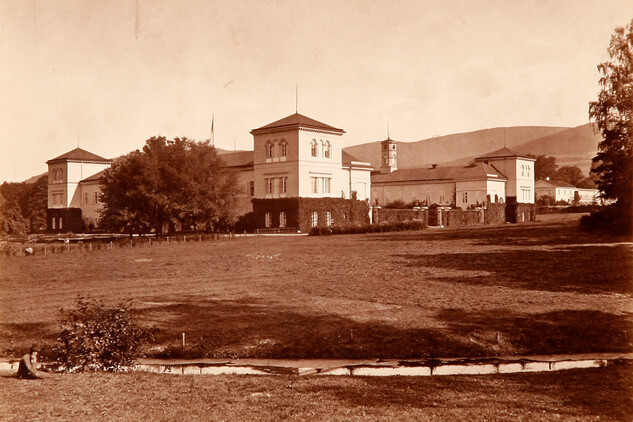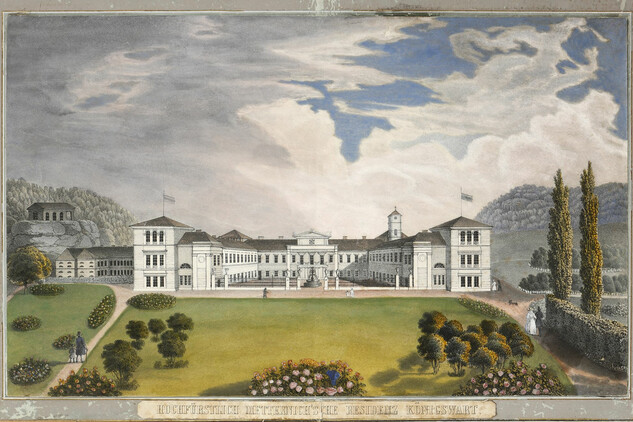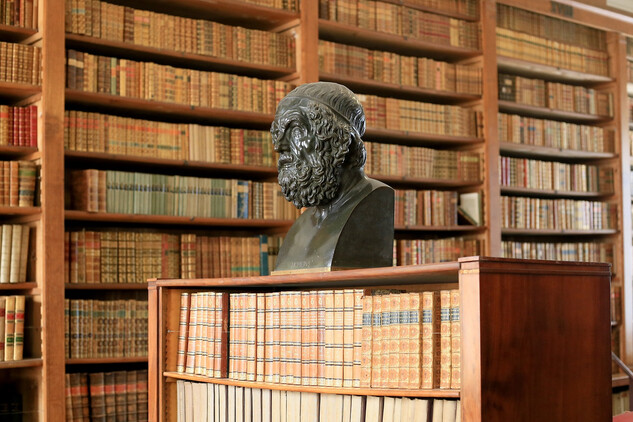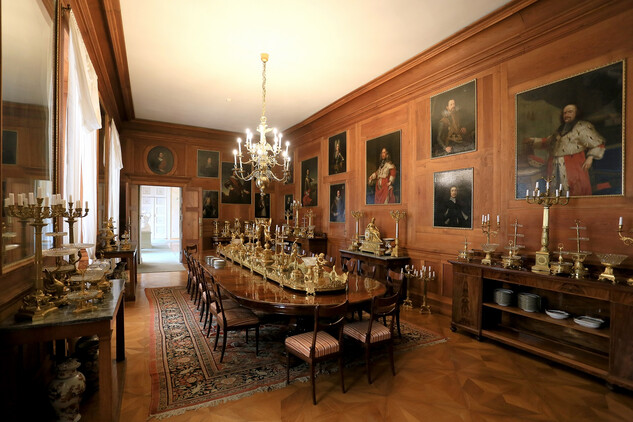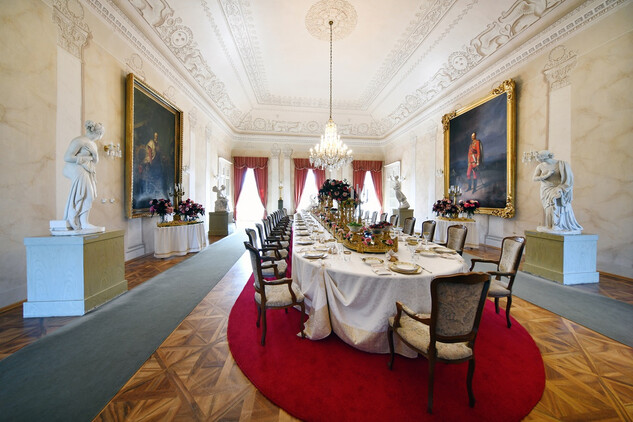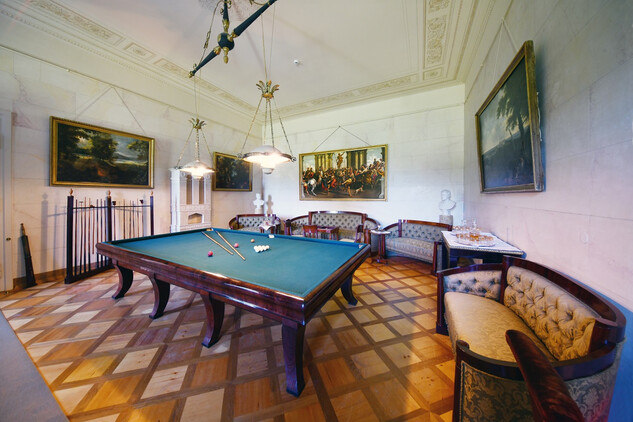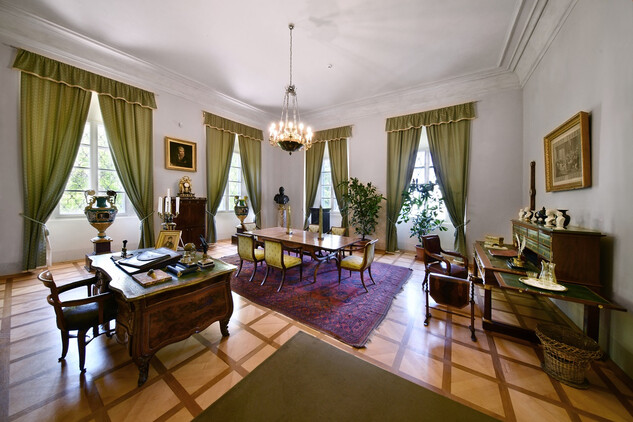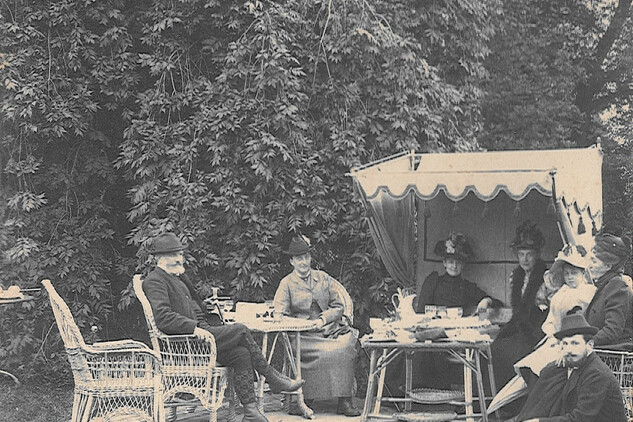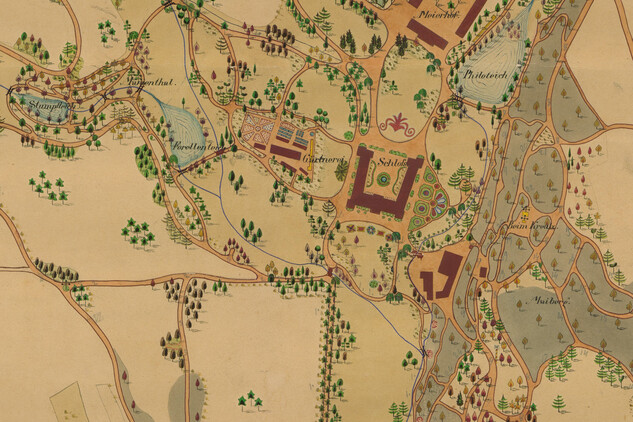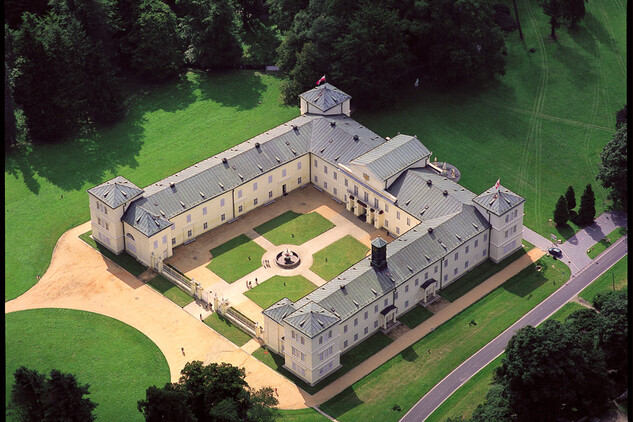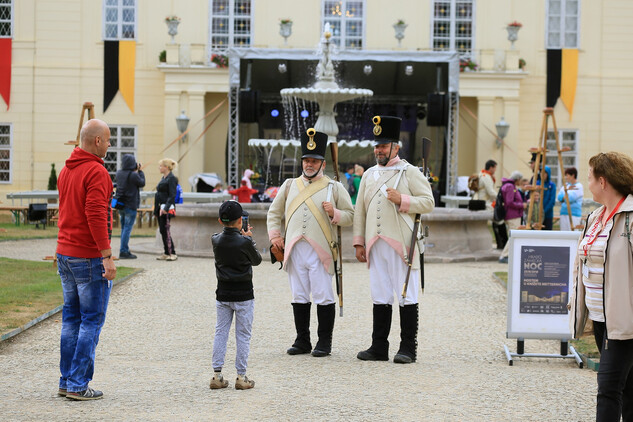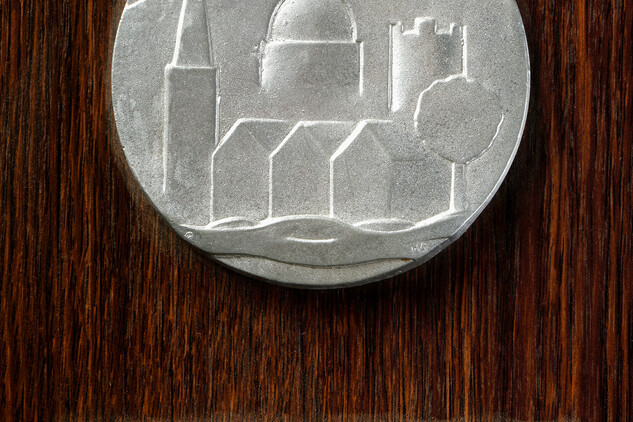Kynžvart Castle – History
Kynžvart Castle
The history of Kynžvart starts in the latter half of the 13th century. At that time, the Czech King Premysl Otakar II ordered here the erection of a borderland castle, called Kunigeswart, ruins of which can still be seen atop the steep rock above the township of Lazne Kynžvart. In the course of 340 years up to the Thirty Years' War, the castle experienced a rapid succession of 29 owners, descending from ten noble families (in particular, lords of Kynžvart, Osek, Plauen, Švamberk, Pluhs of Rabštejn, and lords of Cedvice and Libštejn).
A Renaissance keep was erected below Kynžvart by the lords of Cedvice in the late 16th century. In 1623, after the Battle of White Mountain, the confiscated demesne of Kynžvart, along with the castle and the Renaissance keep, was taken over by Johann Reinhard and his brothers Wilhelm, Karl, Emmerich and Lothar – officers of General Wallenstein's army and nephews of Lothar Metternich, Archbishop and Elector of Trier. Then, the Metternichs kept the domain of Kynžvart until its confiscation in 1945. Between 1681 and 1691, Count Philipp Emmerich ordered the replacement of the dilapidated Renaissance keep with a Baroque mansion.
Klement Wenceslas Lothar Johann Nepomuk, the second Prince of Metternich – Winneburg, was born on 15 May 1773 in the Palatine-Rhenish town of Coblenz.
He served as Austria's envoy to Dresden, Berlin and Paris. Between 1809 and 1848 he occupied the post of Austria's Minister of Foreign Affairs. In addition, he became the State Chancellor of Austria in 1821. In 1813 he was elevated to hereditary princedom. Convened under his auspices upon the defeat of Napoleon, the Congress of Vienna (1814–1815) addressed international relations by ushering in a system of treaties between the major powers.
Between 1820 and 1839 Pietro Nobile conducted the remodelling of the castle in the style of Viennese Classicism.
At the outset of the revolution in March 1848 and after having handed in his resignation, the Chancellor left for London to live there in voluntarily exile. Following his return three years later, he frequently stayed at Kynžvart until his death on 11 June 1859.
Collections
Splendid interiors of Kynžvart Castle house vast collections of works of art, with four Late Gothic altar-pieces, created by the German painter Bernard Strigel (1460/1461–1528) in 1510, indisputably ranking among the most precious exhibits. Strigel's paramount panels depict the Legend of finding the remains of the Holly Cross. They may have originated from the monastery at Ochsenhausen which was taken over by the Chancellor's father, Prince Francis George of Metternich in 1803.
The collections also include a French Renaissance tapestry with a hunting scene dating back to 1560, and several Renaissance and Early Baroque portraits.
Initially, many items used to adorn Chancellor Metternich's villa in Vienna. In 1906, a collection consisting of 32 paintings, 155 miniatures, 29 marble sculptures, busts, plinths, reliefs and decorative vases was put on display in the Imperial Court's Art Historian Museum. Many portraits were created by well-known painters at the period marked by the convening of the Vienna Congress - Sir Thomas Lawrence, Sir Joshua Reynolds, Francois Gérard and outstanding painters of miniatures Daffinger and Kriehuber.
Some marble sculptures (e. g. "Cupid and Psyche") originated in Antonio Canova's workshop in Rome, reliefs were made by Bertel Thorwaldsen, while some other sculptures and busts were created by Christian Rauch, Pietro Fontana, Pompeo Marchese, Giuseppe Pisani and Pietro Tenerani. In total, this unique set consists of 36 marble Classical sculptures.
In 1908 these works of art were transferred to Kynžvart (including the French Imperial Style decorative vases and plinths made of malachite, porfyrite, alabaster and marble).
The Chancellor's Library of Kynžvart Castle ranks among the most significant aristocratic libraries throughout the Czech Republic. This encyclopaedic library contains more than 12,000 titles in 24,000 volumes. Among its 160 manuscripts there is a unique fragment of the Pentateuch dating back to the turn of the 9th century. 230 incunabula in 145 volumes represent the largest collection of this kind in the Czech Republic.
This library originated thanks to Lothar of Metternich (1551–1623), the Archbishop and Elector of Trier. He namely bequeathed his books to his five nephews who gained the Kynžvart domain in 1623. Unfortunately, most books irrevocably disappeared during the 1794 war events in the Rhenish town of Coblenz.
Remnants of the family library were, however, considerably enriched with about 4,000 extremely precious manuscripts and prints from the abolished library of the dissolved Benedictine monastery at Ochsenhausen (Swabia). The secularized monastery was conveyed to the Chancellor's father Francis George to compensate his losses suffered on the Rhine. After having been brought from Vienna at the behest of Prince Klemens of Metternich, sometime after 1818, the library was installed in the new wing of the remodelled Kynžvart Castle after 1835.
In addition to ancient ecclesiastical texts and works dealing with profane and ecclesiastical history, the library thematically covers biography, heraldry, numismatics, Old Greek and Roman literature, natural science, medicine, musicology, encyclopaedias, atlases, books of travel, descriptions of foreign countries, grammars of various Oriental languages, history of books and printing, philosophy, hermetic sciences, canonical and civil law, political science, diplomacy, economics, exact sciences, technology, mathematics, physics, chemistry, mineralogy, zoology, botany, astronomy, architecture, art history, and art theory. It is no exaggeration to say that here almost all professions can find fundamental historic sources addressing their branches of study.
A 12th-century set of 17 manuscripts also includes two precious leaves written in St. Bernard of Clairvaux' own hand. Apart from biblical or liturgical books, homilies and theological treatises, the collection of ancient manuscripts also includes juridical and philosophical writings. A 13th-century illuminated book of psalms ranks among the most magnificent items of this library. The 14th-century manuscript "Legenda sanctorum" also containes a manuscript "Sufferings of St. Adalbert" by Bruno von Querfurt, as well as a sermon on St. Gorgonius written by St. Adalbert. The lavishly illuminated two-volume manuscript "Histoire de France" also dates back to the 14th century. Furthermore, frequently cited are the 1525 "Chronicle of Magdeburg" and a manuscript by the Spanish writer and playwright Felix Lope de Vega Carpio.
The collection of incunabula also contains quite excellent items, for example a cosmography by Hartmann Schedel and the first printed edition of "Aristophanes' Comoedie". In the 19th century, the incunabula "Soliloquium…" by Hugo de Sancto Victore was mistook for a print originated in Johann Gutenberg's workshop.
Unfortunately, all medieval manuscripts, incunabula and most old prints were rebound in the 19th century, with only six codices keeping their original bindings.
The fundamental index of the Chancellor's library was completed by the castle's librarian Heinrich Schiel between 1845 and 1853. The eight-volume author and subject catalogue, and later indices of manuscripts, incunabula, maps, plans and graphics have been preserved up to now.
In addition, the castle library also includes a priceless collection of about 8,000 graphics. As for their technique, lithographs, copper-engravings and steel-engravings prevail. This collection of various genres and techniques is added to with calligraphic letters, copper plates, or trial prints.
In the castle's dining-hall there is a unique mirror-like table service made of brass and gilded by the Thomire company in Paris in the late 18th century. This luxurious service was presented to Prince Richard Metternich.
Consecrated to St. Anthony of Padua, the castle's chapel dates back to 1833. In the course of the Classical remodelling, the furnishings of the original Baroque chapel were donated to neighbouring villages. Hence, the Baroque cross and organ went to Dolní Žandov, while the carved statuettes of St. John and Virgin Mary went to St. Anne's chapel in the nearby village of Stará Voda.
Between 1824 and 1832, a new high altar of this chapel was built from marble remnants of the cathedral of St. Paul Outside the Walls (San Paolo fuori le mura), one of Rome's most ancient basilicas which burnt down in 1823. Made for Chancellor Metternich at Pope Gregory XVI's suggestion, the altar contained remains of St. Boniface. Moreover, the dedication charter issued by the Pope mentions various privileges. Brass statues of St. Peter and Paul were added to the tabernacle.
The main altar-piece representing the Vision of St. Anthony of Padua was made by the Viennese painter Anton Petter in 1832. Created in the Late French Imperial Style, the white marble sculpture next to the altar represents the Guardian Angel. Opposite the altar there is a painting by the Italian Baroque painter Luca Giordano (1632–1705), showing the Deposition from the Cross. Heraldic banners of Chancellor Metternich and his third wife hang from the oratory's windows.
Attended by the Queen of Württemberg, the first divine service in the remodelled chapel was celebrated in July 1833. Pilgrimage masses honouring St. Anthony were held in the castle's chapel until 1957. In August 1999 the chapel was re-consecrated by Frantisek Radkovsky, the Bishop of Pilsen, with the holy mass again being celebrated here after a long 42 years. Simultaneously, the tradition of pilgrimage masses honouring St. Anthony was revived at Kynzvart in 2000.
Atop the May Hill in the castle park, the wooden forest chapel of the Holy Cross was built in 1835. Earlier, the tradition has it that this location was used to serve as a pagan place of sacrifices. Following the erection of a small chapel at the behest of Philipp Emmerich of Metternich in 1692, a hermit settled down nearby to prevent the local residents from observing heathen customs.
Emblazoned with several charming legends, the Neo-Gothic forest chapel of the Holy Cross was erected in September 1835 to highlight the visit by the Austrian Emperor Ferdinand V. The wooden Baroque cross is flanked with stones bearing inscriptions dating back to 1692.
The Old Curiosity Cabinet is one of the oldest public museums throughout Europe. Its inception is connected with Karl Huss, the last executioner employed by the town of Cheb (1827–1838) and a renowned regional historian and philosopher. His collections of coins, products of nature and historic curiosities became the foundations of Kynzvart Castle's museum.
Karl Huss' numismatic collection (originally 7,109 coins) was considerably enriched thanks to the acquisition activities of Chancellor Metternich and his son, Prince Richard. Considering the uniqueness of its 11,000 items, this collection ranks among the most significant ones in this country. As for the set of 2,000 ancient means of payment, Roman coins are prevalent. Nevertheless, the core of this collection mainly consists of coins and medals dating back to the Late Middle Ages and the Early Modern Times; in particular, to the thaler period. Generally, this collection is devoted to the aristocratic, municipal and ecclesiastical coinage in Germany, with Oriental coins and means of payment only marginally represented. In this connection, however the lively social and diplomatic contacts of Prince Metternich with the then Viceroy of Egypt are patently obvious.
The Old Curiosity Cabinet includes several dozen items of paraphernalia which used to belong to well-known historic celebrities - King Matthias Corvinus' travelling clock and his gold ring with three diamonds and four rubies; a gold signet-ring of the Polish Queen Marie Sobieski; a sword of Louis XIV; a child's dress worn by Don Carlos; Pope Gregory XVI's pontifical shoe; Duke Wellington's overcoat; a collection of walking sticks which were originally owned by various dignitaries including Secretary Talleyrand and Emperor Francis I; gloves of the executed Mexican Emperor Maxmilian; a cigarette of Emperor Napoleon III, along with a dagger which adorned his fancy dress; Empress Eugenie's tambourine; Alexander Dumas the Elder's chair and writing desk scrawled with his notes and signatures, as well as a posthumous cast of his right hand; a hand-written score by Richard Wagner, including his dedication to Princess Pauline of Metternich; and signatures and manuscripts of various important persons.
Moreover, the museum has also been enriched with ancient relics excavated on Greek and Roman archaeological sites. Some artefacts were found in Pompeii, Mexico or Peru. Especially valuable are Old Egyptian relics presented to Chancellor Metternich by the Ottoman Viceroy of Egypt, Muhammad Ali, in 1825. They include the mummies of Ken Amon, a priest and guardian of Pharaoh Thutmosis III's treasure (18th dynasty, 15th century BC) and another priest called Pentahutra (21st dynasty, 11th century BC). Both mummies rest in their original wooden coffins with ornately decorated covers bearing illuminated texts and symbolic ornaments. This collection is completed with pieces of hieroglyphic papyruses, bandage tissues, amulets and other items of the sepulchral outfit.
Relics commemorating the Spanish national hero Cid and his wife Ximene originated in the 11th century, while the relics of Pope John XXII date back to 1334. A fragment of Emperor Charles V's coffin is kept inside a splendid reliquary. You can also see here a medallion containing a lock of Emperor Napoleon I's hair, together with a lock of Empress Maria Theresa's hair and hair from Duke Wellington, Ludwig van Beethoven, Luigi Cherubini, Gaspar Spontini, Emperor Francis I and other celebrities.
Some exhibits were retrieved from assumed or genuine historic places - for example, a piece of brick from the Babylonian Tower; a stone from the area where the towns of Sodom and Gomorrah were situated; a piece of stone from the Temple of Jerusalem; a piece of wood from the Roman Emperor Tiberius' ship; a fragment of an ornament from Livia Drusilla's bath; mosaic cubes from St. Mark's church in Venice; or mosaic cubes from the cupola of the Hagia Sofia temple in Istanbul. The meerschaum pipes and Oriental amulets date back to the 1683 siege of Vienna by Turkish troops.
Some exhibits are mainly valuable because of their authentic connection to specific historic events. On that account, they commemorate both local tragedies and events of world history. They include: a piece of skin taken from the body of a coachman who lost his life in a 1782 accident in Prague; wall papers from Marie Antoinette's prison cell, bearing a message she wrote to the French nation; a banner dating back to the Great French Revolution; a carabine and a case shot found on the battlefield at Leipzig; and another case shot found on the battlefield at Waterloo. An unexploded bomb used during the attempt on Emperor Napoleon III's life may be the only preserved and functional one from the set of ten bombs made for the anarchist Orsini.
The end of the Chancellor's political career is commemorated by a grenade ball which was shot into his study during the bombardment of Vienna in October 1848.
Museum catalogues have been preserved up to date. Thoroughly describing the exhibits and determining their authenticity, origin and location in the show-cases, they provide a source of valuable information necessary for the reconstruction of the authentic lay-out of the collections.
The Chancellor's son, Prince Richard, also played an important role in completing the Old Curiosity Cabinet. Thus the collections include, for example, a ticket to the World Exhibition held in Paris in 1867, letters sent by carrier pigeons, or a lump of bread from the beleaguered city of Paris.
Many curiosities demonstrate the technical progress and the workmanship of their creators. This group of relics includes: dozens of onyx or cornelian cameos, gold rings, brooches, pendants, pins with brilliants, pearls and semi-precious stones; sealing sticks, signet rings; plaques and relief portraits made of glass, plaster, wax, cast iron or porcelain; miniature portraits and historic scenes; replicas of ancient gems and cameos made by L. Pichler; plaster plaques made by the workshop of Antonio Canova and Bertel Thorvaldsen; the oldest daguerreotypes, with one of them dedicated to Metternich by L. J. M. Daguerre; optical devices and frames; a model of a Transatlantic telegraph cable etc.
The Oriental curiosities include: a full Japanese samurai armour; spears from Java; clubs from the Pacific islands (with shark teeth); a headband worn by Chinese brides; a Dayak chieftain's crown; the Egyptian Viceroy's Arabian horse saddle with holsters; sand from three deserts, as well as countless products of nature from far-away countries.
The instruments of torture are added to with swords of the executioner employed by the town of Cheb, historic weapons, helmets and caps of significant European regiments.
Park
The castle park was laid out by the Viennese court gardener Riedl when the castle was remodeled in the French Imperial Style (1820–1833). The key composition of the park was preserved by reorganising the original flora and planting new domestic wood species, two main axis were enhanced with three dominant vistas of the castle. Simultaneously, park buildings were remodeled, other buildings were erected and some architectural features were added to emphasize the splendour of the surrounding landscape. Directly opposite to the castle, the Chancellor ordered the erection of a group of farmstead outbuildings, the new complex housed the Pension Office and the Forestry Office. In close vicinity to the castle, several structures were renovated, including the gardener's villa and greenhouse, the brewery (mentioned as early as 1606) and the gamekeeper's lodge. The ancient mill and the shingle-roofed smithy dating back to the late 18th century were also refurbished. At that time the southernmost border of the park constituted a ridge above the brewery, featuring an Imperial Style tea-house and the forest chapel of the Holy Cross replacing a former Baroque hermitage.
At the Chancellor's order, an obelisk was erected atop St. Anthony's Hill to honour emperors Francis I and Ferdinand V. Striking features of the park include cast iron adornments made at Metternich's iron works – the courtyard fountain, decorative lattice of the honorary court, a statue representing Diana, benches, railings and a Romantic hexagonal pavilion.
At the conclusion of his diplomatic career in 1870, Prince Richard, the Chancellor's son and heir returned to Kynžvart. The park was greatly extended thereafter, reaching Kynžvart in the north and the railway in the south. Many exotic species were planted, especially conifers. Eventually, a thick hedge formed encircling the park. With the simultaneously completion of a pond system, the park was also enhanced with countless romantic recesses and resting places.
In the early 20th century, the park began to deteriorate, uncontrolled spreading of undesirable trees and bushes caused enormous devastation. The gradual reconstruction of the park and its paths has only recently begun.
